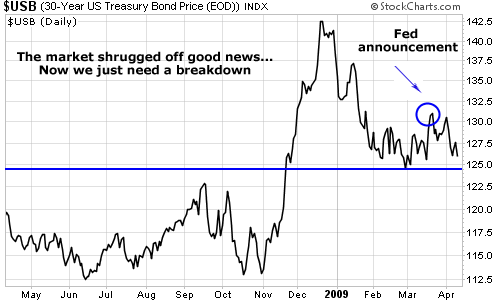What to Do When the U.S. Treasury Bond Market Falls
Interest-Rates / US Bonds Apr 14, 2009 - 02:02 AM GMTBy: DailyWealth

 Tom Dyson Writes: Jesse Livermore called it "the path of least resistance." Livermore is probably the greatest trader that ever lived. He made his first fortune in the stock market as a teenager... in the late 1890s. The book of his trading techniques – Reminiscences of a Stock Operator – is the best book on stock market trading ever written. You shouldn't buy another stock until you've read it. (Just don't copy his money-management techniques. By overtrading, Livermore made and lost several multimillion-dollar fortunes in his lifetime.)
Tom Dyson Writes: Jesse Livermore called it "the path of least resistance." Livermore is probably the greatest trader that ever lived. He made his first fortune in the stock market as a teenager... in the late 1890s. The book of his trading techniques – Reminiscences of a Stock Operator – is the best book on stock market trading ever written. You shouldn't buy another stock until you've read it. (Just don't copy his money-management techniques. By overtrading, Livermore made and lost several multimillion-dollar fortunes in his lifetime.)
As Livermore explains in Reminiscences, prices will always do what comes easiest. There will usually be more resistance on one side of the market than on the other. If there's more resistance on the downside, prices tend to rise. If there's more resistance at higher prices, they tend to fall.
So when the path of least resistance is down, you need to be short. When the path of least resistance is up, you need to be long. Trading stocks is as simple as that. If you can always follow the path of least resistance with your trades, you'll get rich.
The trouble is, it's a simple matter to identify the path of least resistance in hindsight... But in real time, it's not so easy.
So I follow two indicators...
My first indicator uses "breakouts" to define the path of least resistance. When a price breaks to a new high or low, the market's telling you which way it wants to move. To make money, you should follow the breakout.
I use a 65-day breakout, but you can measure breakouts any way you like. The number of days makes no difference. I like to hold my positions for several months and I've found that a 65-day breakout suits my trading style.
My second indicator uses market sentiment to give the signal. When the path of least resistance is down, the market tends to shrug off good news and react very strongly to bad news. When the path of least resistance is up, the market soars on good news and ignores any negative stories.
When both of these signals line up, you are trading along the path of least resistance and you have a high-probability trade.
Let's take the long Treasury bond as an example. On March 18, Fed Chairman Bernanke announced he would use the Fed's money printer to buy $300 billion of Treasury bonds. This should have been wonderful news for prices of Treasury bonds... and for a few days it was.
But in the last month, prices have shrugged off this "wonderful" news and fallen back down. Our sentiment indicator is clearly showing the path of least resistance is down.

Now we're just waiting for the price action to "break down." Right now, the long bond price is $125.92. To confirm the path of least resistance is down, prices need to fall below $124.07. If prices fall below $124.07, both indicators will be flashing together.
If this happens, I'll let you know in DailyWealth. I'll also tell you exactly what to do next...
Good investing,
Tom
The DailyWealth Investment Philosophy: In a nutshell, my investment philosophy is this: Buy things of extraordinary value at a time when nobody else wants them. Then sell when people are willing to pay any price. You see, at DailyWealth, we believe most investors take way too much risk. Our mission is to show you how to avoid risky investments, and how to avoid what the average investor is doing. I believe that you can make a lot of money – and do it safely – by simply doing the opposite of what is most popular.
Customer Service: 1-888-261-2693 – Copyright 2009 Stansberry & Associates Investment Research. All Rights Reserved. Protected by copyright laws of the United States and international treaties. This e-letter may only be used pursuant to the subscription agreement and any reproduction, copying, or redistribution (electronic or otherwise, including on the world wide web), in whole or in part, is strictly prohibited without the express written permission of Stansberry & Associates Investment Research, LLC. 1217 Saint Paul Street, Baltimore MD 21202
Disclaimer: The above is a matter of opinion provided for general information purposes only and is not intended as investment advice. Information and analysis above are derived from sources and utilising methods believed to be reliable, but we cannot accept responsibility for any losses you may incur as a result of this analysis. Individuals should consult with their personal financial advisors.
Daily Wealth Archive |
© 2005-2022 http://www.MarketOracle.co.uk - The Market Oracle is a FREE Daily Financial Markets Analysis & Forecasting online publication.


